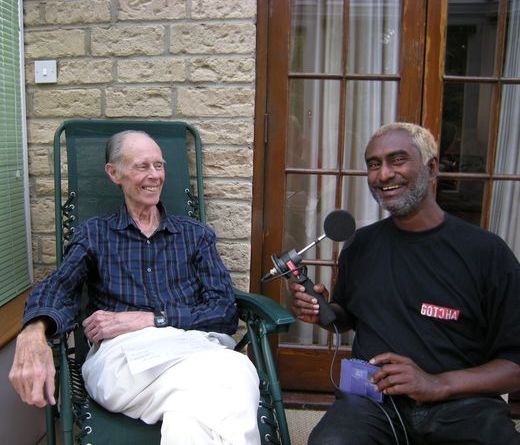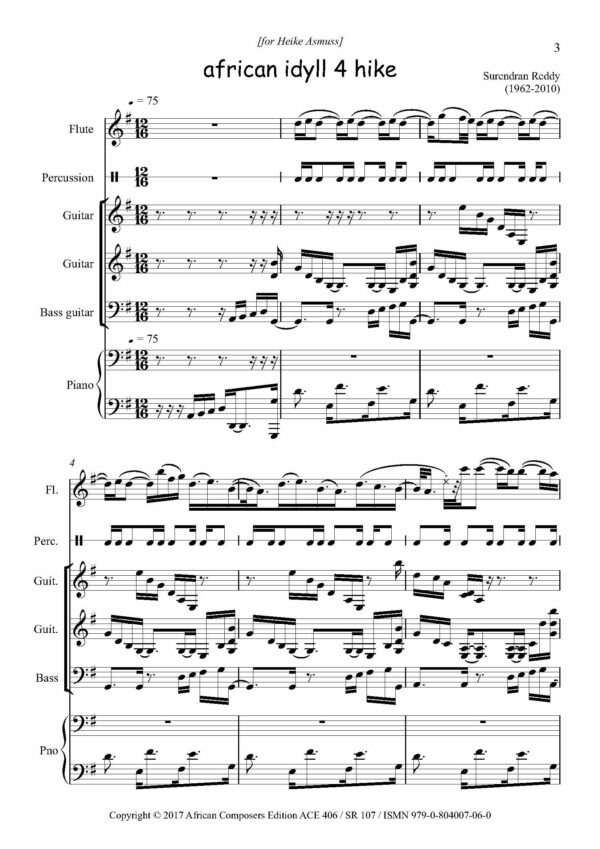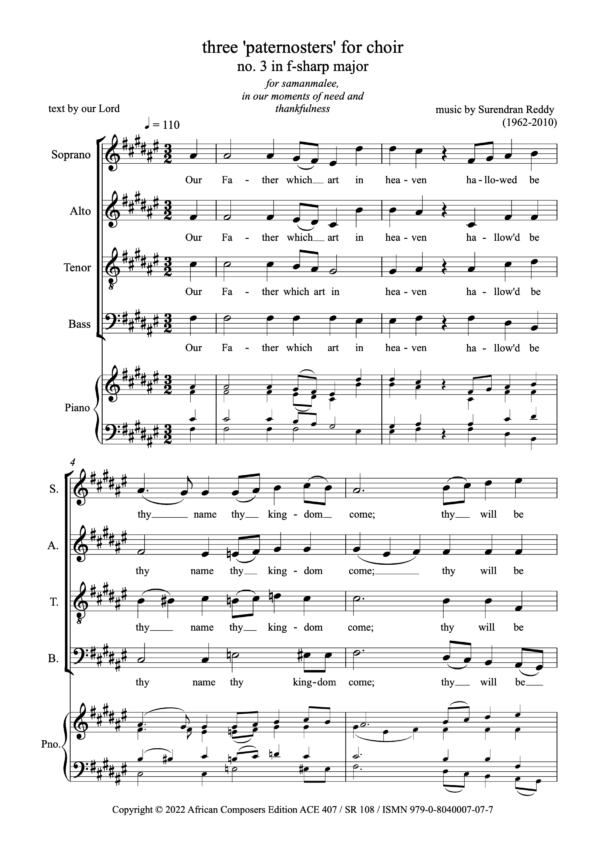missa gratias per antonius

R0.00
The missa gratias per antonius (mass of thanksgiving for anthony) is one of many works by Surendran Reddy that remained unfinished when he died on 22 January 2010. In this long and joyful work, Reddy celebrates the life of one of his earliest music teachers, Anthony Walker, with whom he had studied when Walker taught at the Rhodesian Academy (now Zimbabwe Academy) of Music, Bulawayo, in the 1970s. Reddy visited the Walkers at their home in Charlbury, near Oxford (a place Reddy loved) in the summer of 2008. He was accompanied by his long-time partner, Heike Asmuss, after whom african idyll for hike (2009) is named and which became the ‘introitus’ of the missa per antonius. Reddy and Walker had long discussions that Reddy recorded, but Walker was terminally ill and died in December 2008. The image to the right shows Reddy and Walker outside the Walkers’ house.
Reddy modelled his work on the five-part liturgical mass but clearly envisaged giving it a more unconventional structure, by excluding the ‘Credo’ and adding an ‘introitus’ and a ‘valediction’ at the end, adding three ‘pater nosters’, a psalm (23) and ‘Amazing Grace’ – to the conventional sequence of Kyrie, Gloria, Sanctus and Agnus Dei. The Sanctus is just a few bars of ideas and the other movements vary from a state of more or less completion to half or barely complete, meaning that the text is not matched to vocal parts or vocal parts do not yet exist, or there are many empty bars. As the surviving Sibelius scores show, Reddy tended to write for piano first, with words here and there indicating what might be sung and vocal or instrumental parts sketched in or sometimes fully written out for a few bars. He drew on some of his own music to make two of the movements: the opening movement uses african idyll for hike and the ‘Amazing Grace’ section draws on Reddy’s piano piece forbidden wedding II (2007).
Reddy made 17 mp3s of his planned sections, which are given below in order to get an idea what the music sounds like, bearing in mind that the introitus, paternosters, kyrie and gloria are more complete than the other sections. Reddy did not, however leave 17 Sibelius files with the exact same titles as the mp3s, which has made piecing the work together a little complicated. Mp3 1, ‘introitus’, is related to two Sibelius files called ‘missa 1 – african idyll’ and ‘open version for improv’. Mp3 2, ‘pater noster’, corresponds exactly to ‘missa 2 pater noster 1 in g major’ in a Sibelius file dated 30.9.10. Mp3s 3, 4 and 5 are all ‘kyries’ and correspond to one Sibelius file that has many empty bars at the end. Mp3s 6 and 7, ‘pater noster II and IIb, correspond to one Sibelilus file called ‘pater noster 2 in D’ completed on 1 December 2009. Mp3s 8 and 9, ‘psalm’ and ‘psalm b’ are very short and correspond with the Sibelius file ‘psalm 23’ dated 18 October 2009. Mp3 10, ‘gloria’, is identical to the Sibelius file ‘gloria’ of 1 December 2009. Mp3 11, ‘amazing grace a cappella’, is identical to the Sibelius file of the same name, dated 1 December 2009. Mp3s 12 and 13, called ‘variations pour une’ and ‘variations b’, correspond to the Sibelius file ‘variations on amazing grace 4 diana’; there are no words here, however, and this is a piano score from beginning to end, so it is unclear what part of the mass it was destined for. Mp3 14, ‘pater noster III’ is the Sibelius file ‘our father f-sharp major’ of 1 December. Mp3 15 is an unfinished ‘agnus dei’ as is the Sibelius file ‘agnus dei 2’, also 1 December. Mp3 15 is called ‘pater noster IV to ite mitta est’, the latter phrase meaning ‘go, you are dismissed’ and spoken at the end of the Roman Catholic mass. The corresponding Sibelius file may be ‘idea – maybe pater noster’, dated 18 December, but in fact this is the same as ‘pater noster 1 in g major’. The 17th mp3, ‘repeat introitus music’ is an exact repeat of the first, but there is also a Sibelius file called ‘valediction for hike’ in which the music is different. Then there are two remaining Sibelius files: ‘idea 4 sanctus’ which is only a few bars long, and ‘fear mode’ which is a one-page sequence of chromatic chords harmonizing an invented scale; again, it is difficult to know in the latter case where this would have fitted into the mass although one can understand the title. Reddy was terminally ill by the time he came to write the mass.
The whole work is imagined for SATB choir, strings and piano except the ‘introitus’ which, because it is based on african idyll is scored for SATB choir, flute, percussion, two guitars, bass guitar, piano, and five-part strings. The most complete sections are worth listening to first: aside from the ‘paternosters’ these are the ‘introitus’, the ‘kyrie’, and the ‘gloria’.
ACE has not attempted to ‘complete’ the missa but has reconstruct the three ‘pater nosters’, which are available here, and has made available to scholars Reddy’s pdf ‘missa 1st sketches’, which corresponds to the 17 numbers listed above albeit with many empty bars or pages. (Scroll down to see the pdf.) This was probably intended as a ‘proof’ on which to work further, but sadly, this was was not possible. Reddy was only too aware that Mozart, of whose music there are many echoes in the missa, had died leaving his requiem unfinished, which adds a particular poignancy to this unfinished work.




